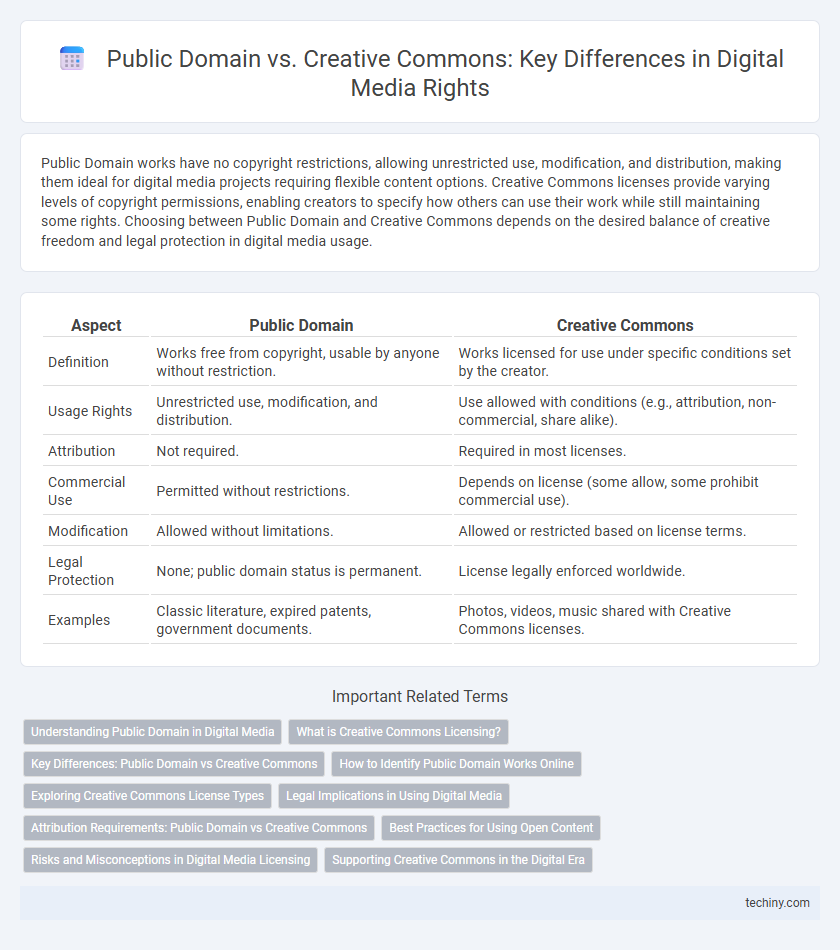Public Domain works have no copyright restrictions, allowing unrestricted use, modification, and distribution, making them ideal for digital media projects requiring flexible content options. Creative Commons licenses provide varying levels of copyright permissions, enabling creators to specify how others can use their work while still maintaining some rights. Choosing between Public Domain and Creative Commons depends on the desired balance of creative freedom and legal protection in digital media usage.
Table of Comparison
| Aspect | Public Domain | Creative Commons |
|---|---|---|
| Definition | Works free from copyright, usable by anyone without restriction. | Works licensed for use under specific conditions set by the creator. |
| Usage Rights | Unrestricted use, modification, and distribution. | Use allowed with conditions (e.g., attribution, non-commercial, share alike). |
| Attribution | Not required. | Required in most licenses. |
| Commercial Use | Permitted without restrictions. | Depends on license (some allow, some prohibit commercial use). |
| Modification | Allowed without limitations. | Allowed or restricted based on license terms. |
| Legal Protection | None; public domain status is permanent. | License legally enforced worldwide. |
| Examples | Classic literature, expired patents, government documents. | Photos, videos, music shared with Creative Commons licenses. |
Understanding Public Domain in Digital Media
Public domain in digital media refers to creative works no longer protected by copyright, allowing unrestricted use, distribution, and modification. These works include expired copyrights, government publications, and forfeited rights, enabling creators and users to freely incorporate them into new projects without seeking permission. Leveraging public domain content enhances digital creativity, preserves cultural heritage, and supports open access to knowledge.
What is Creative Commons Licensing?
Creative Commons licensing provides a standardized way for creators to grant the public permission to use their digital media while retaining certain rights. It offers flexible options such as Attribution, ShareAlike, and NonCommercial, allowing users to legally share, remix, or adapt content under specified conditions. This licensing system helps balance creator control with broader access, fostering collaboration and innovation in digital media.
Key Differences: Public Domain vs Creative Commons
Public Domain works are free from copyright restrictions, allowing unrestricted use, modification, and distribution without needing permission or attribution. Creative Commons licenses provide a flexible range of protections and freedoms, enabling creators to specify conditions such as attribution, non-commercial use, or share-alike requirements. Understanding these key differences is essential for digital media creators to legally share, remix, or repurpose content while respecting intellectual property rights.
How to Identify Public Domain Works Online
Identifying public domain works online involves checking for explicit declarations on digital libraries or archives such as Project Gutenberg, Wikimedia Commons, or the Library of Congress, where materials are often tagged with their copyright status. Users can verify publication dates, as works published before 1924 are generally in the public domain in the United States, and review the presence of Creative Commons licenses, which clearly specify the allowed uses and restrictions. Employing metadata tools and copyright databases can further confirm whether a work has entered the public domain or remains protected under Creative Commons licenses.
Exploring Creative Commons License Types
Creative Commons licenses offer a range of options that balance creator rights with public accessibility, including Attribution (CC BY), Attribution-ShareAlike (CC BY-SA), and Attribution-NonCommercial (CC BY-NC) licenses. Each type defines specific permissions regarding sharing, modifying, and commercial use, providing flexibility for digital media creators to control how their work is used. Understanding the distinctions between licenses like CC BY-ND (NoDerivatives) and CC BY-NC-SA ensures proper compliance and maximizes the legal sharing of creative content in digital platforms.
Legal Implications in Using Digital Media
Public domain digital media refers to works whose copyrights have expired or were never eligible, allowing unrestricted use without legal consequences. Creative Commons licenses provide a flexible range of permissions, requiring users to comply with specific terms such as attribution, non-commercial use, or share-alike conditions to avoid copyright infringement. Understanding these legal distinctions is critical for content creators and digital marketers to ensure compliant use and distribution of digital assets.
Attribution Requirements: Public Domain vs Creative Commons
Public Domain works require no attribution, allowing unrestricted use, modification, and distribution without crediting the original creator. Creative Commons licenses often mandate attribution, ensuring the creator receives recognition while enabling various levels of usage rights depending on the specific license chosen. Understanding the distinct attribution requirements helps digital media professionals legally share and adapt content while respecting intellectual property rights.
Best Practices for Using Open Content
When using open content, clearly verify the license type--public domain materials allow unrestricted use, while Creative Commons licenses require adherence to specific conditions such as attribution, non-commercial use, or share-alike clauses. Always provide proper credit to original creators, respect license restrictions, and document sources to maintain transparency and legal compliance. Employ trusted repositories like Wikimedia Commons or Creative Commons Search to access verified open content and avoid copyright infringement risks.
Risks and Misconceptions in Digital Media Licensing
Public domain works are free from copyright restrictions, but mistakenly assuming all online materials are public domain can lead to legal risks. Creative Commons licenses require proper attribution, and misunderstanding license terms may result in unintentional copyright infringement. Digital media users must carefully verify the license type and compliance requirements to avoid potential legal consequences and protect intellectual property rights.
Supporting Creative Commons in the Digital Era
Creative Commons licenses enhance digital media sharing by granting clear, flexible permissions that empower creators and users alike. Supporting Creative Commons fosters innovation, broadens access to knowledge, and safeguards the rights of digital content creators in an increasingly interconnected online environment. This licensing framework complements the public domain by offering tailored options that balance creative freedom with legal protection.
Public Domain vs Creative Commons Infographic

 techiny.com
techiny.com